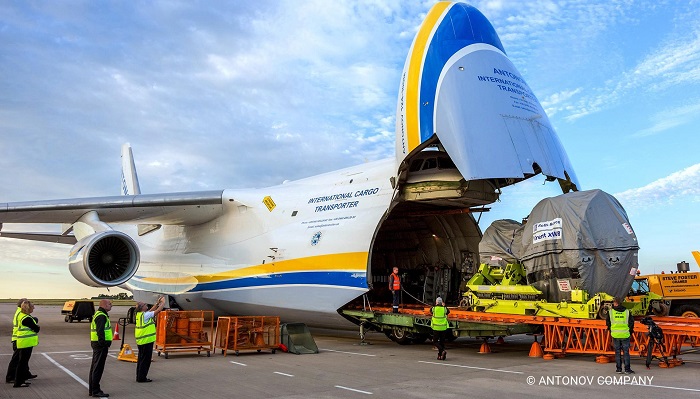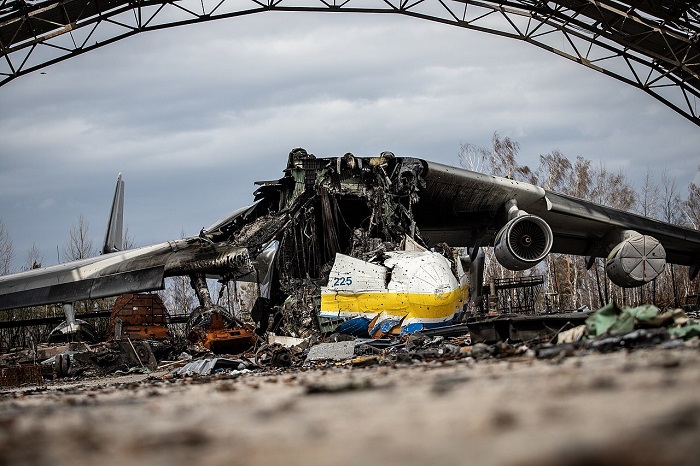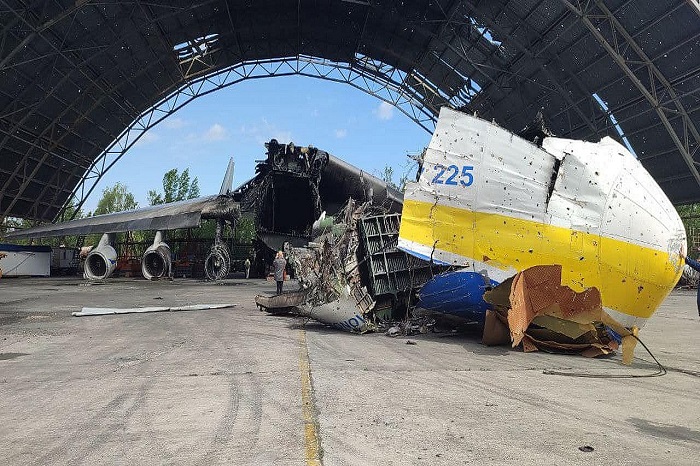ISABEL RUBIO ARROYO | Tungsteno
The world's largest aircraft, the Antonov An-225, has been destroyed during the Russian invasion of Ukraine. As well as being the heaviest cargo aircraft ever to take to the skies, it was once the star of air shows in Canada, Great Britain and the USA and has transported all kinds of goods, from locomotives and satellites to planes, trucks, food and medicines. In fact, it broke the record for cargo volume when it transported medical equipment during the COVID-19 pandemic. We take a look at the history of this gigantic aircraft, equipped with six engines and 32 wheels, which holds dozens of Guinness World Records, and how its owners are now planning to rebuild it.
A legendary aircraft
The An-225's story begins in the 1960s and 1970s, when the Soviet Union was in the middle of a space race with the United States. This aircraft, called Mriya, or 'dream' in Ukrainian, was built in the Ukrainian Soviet Socialist Republic, It was intended to carry the Energia carrier rocket and the Buran spacecraft between space facilities in the former Soviet Union. This giant of the skies first took off in 1988 and was the inspiration for Antonov Airlines' slogan: "No other name carries more weight."
As well as being the heaviest aircraft ever built, it was also the longest-span aircraft in service (some 88.4 metres). Powered by six turbofan engines, it has a length of 84 metres, a height of 10.2 metres and a maximum payload of 250 tonnes, which can be carried internally or externally on its upper fuselage. That's the weight of 250 cars or 5,000 truck tires. The An-225 entered commercial service in 2001. Since then, it has flown all over the world carrying cargo such as electrical transformers and mobile power generators.
It has also been used to move supplies during some humanitarian crises. Following the 2010 earthquake in Haiti, it flew material to the neighbouring Dominican Republic. During the early days of the COVID-19 pandemic, it was also used to transport medical supplies to affected areas. The plane carried 100 tonnes of medicines, laboratory test reagents, medical masks and other protective gear representing a volume of 1,000 cubic metres.

The Antonov An-225 has a maximum payload of 250 tonnes, which can be carried internally or externally on its upper fuselage. Credit: Antonov.
The 'dream' was cut short
The aircraft was to remain in operation until at least 2033, according to its creators. But the Russian invasion of Ukraine cut these plans short. The aircraft was parked at an airfield near Kiev when it was attacked by "Russian occupiers" on 27 February 2022, Ukrainian officials said. "The nose of the plane was completely destroyed, seemingly the victim of a direct artillery hit," says CNN journalist Vasco Cotovio, who was later on the scene. There was also serious damage to the wings and some of the engines. Although the tail end "was spared major impacts, it has some holes caused by shrapnel or bullets".
Upon receiving the news, several users expressed their dismay on social media. "Mriya - You will always be remembered! We pay tribute to the world's largest transporter!" said aviation blogger Sam Chui on Twitter. There is no aircraft quite like the An-225. Although the Soviets' intention in the 1980s was to build three aircraft, the sheer size, technical complexity and economic cost meant that only one was ever completed. The Antonov company began construction of a second aircraft, but never finished it.
The Ukrainian authorities have announced their intention to rebuild the aircraft: "We will fulfil our dream of a strong, free and democratic Ukraine". The Ukrainian state defence company Ukroboronprom, which managed Mriya, estimates that restoring the plane will cost over $3 billion and take more than five years. It originally aimed to have the costs covered by the Russian Federation, "which has caused intentional damage to Ukraine's aviation and air cargo sector," it said in a statement in February.

The aircraft was stationed at an airfield near Kiev when it came under Russian attack on 27 February 2022. Credit: Wikimedia Commons.
The challenge of rebuilding the aircraft
Rebuilding a plane of such dimensions and characteristics is a very ambitious challenge. Andrii Sovenko, an engineer and aviation expert who has worked for Antonov since 1987 and has flown on the An-225 as part of its technical crew, stresses that the systems and equipment on board the aircraft have been critically damaged. "Restoring them will be the hardest. This is due to the fact that most of the various electrical systems, pumps and filters used on the An-225 are all from the 1980s," he says. Some of this equipment is no longer in production, so it is unlikely that it can be rebuilt exactly as it was.
The expert believes that "it is impossible to talk about the repair or restoration of this aircraft—we can only talk about the construction of another Mriya, using individual components that can be salvaged from the wreckage and combining them with those that were, back in the 1980s, intended for the construction of a second aircraft," he says.
The Antonov company says that some basic airframe additions for the new aircraft are available, but it stresses that the new Mriya must meet current and future airworthiness standards. This "will require a large amount of design and engineering work, selection and purchase of appropriate components, test program etc." "The amount of funding and the possibility of using the components of the An-225, which was destroyed by Russian troops, will be determined by a special commission," the company says.

The owners of the Antonov An-225 aim to rebuild the aircraft. Credit: Wikimedia Commons.
It’s still too early to say whether the Mriya will eventually be rebuilt. The creators of this legendary aircraft are hoping for international technical and financial assistance, as well as the participation of leading companies in the global aviation industry. What is clear is that there is still a long way to go before such a reconstruction takes flight; for the time being it remains a "dream", honouring the original Ukrainian name of the largest aircraft ever to have flown in the Earth’s skies.
· — —
Tungsteno is a journalism laboratory to scan the essence of innovation. Devised by Materia Publicaciones Científicas for Sacyr’s blog.
